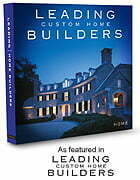Homebuilding has changed significantly over the last hundred years, especially since the 1950s, when the housing industry boomed after World War II. Building a home in a classic, hands-on way is far from standard practice these days, as home construction has evolved from a trade or craft to a systematized process with many moving parts.
Today’s builders manage numerous construction materials and methods, coordinate many trade partners and suppliers, and deal with a variety of building codes and regulations. This complexity may distance homeowners from the actual building process, and can cause uncertainty about where they fit in.
In fact, a homeowner’s role during construction is more important than ever (though different than it was a century ago). The homeowner is still, ultimately, a leader in the project. By gaining a solid understanding of the building process, homeowners can provide an example of professionalism to the rest of the team. Consider the following ‘leadership training’ tips that help define a homeowner’s role on a project:
- Education is key. It pays to learn about the building process and gain an understanding and respect for the pace, phases, and materials that go into a home’s construction. (That is one of our purposes in offering this newsletter.) This knowledge helps the client communicate with the builder and provides confidence as the new home moves through stages of completion.
- Meet deadlines. Builders set deadlines for certain decisions so that materials and labor will arrive on the job site at a certain point during construction, enabling steady progress and on-time completion. Accordingly, builders need homeowners to agree on reasonable deadlines for decisions they have to make, such as selecting cabinets or flooring, and then stick to them. Meeting these deadlines helps keep the construction schedule on track, and it sets a good example for the builder and his suppliers and subcontractors.
- Respect the change order process. Make sure the contract includes a process for managing change orders, which are decisions made (or changed) after an agreed-upon deadline. Most projects will have some changes, but they always cost money and often impact the schedule. It may take time to remove one product, wait for delivery of the new product, and install it. As professional builders, we do our best to accommodate requested changes. For their part, homeowners need to understand the impact a change order has on costs and the schedule—and be prepared to deal with the trade-offs.
- Communicate. Communication is critical, so we ask our clients to share concerns, issues, and ideas. Come into the home building process with an open mind and feel free to ask questions. It’s best to keep a list and present questions during a scheduled meeting or on-site conversation with the builder, but an occasional ad-hoc phone call during business hours is fine.
As a professional builder, we are proud of our business operations and systems. We partner with each of our clients. We understand and respect the relationship we have with our homebuyers. Our savvy customers meet us part of the way, by educating themselves, sticking to deadlines, and asking quality questions.
Make it a great day!
David Baud CGR, CGB, CGP
Baud Builders, Inc. PO Box 5708 Wakefield, RI 02880 (401) 789-1176 – Phone (401) 789-2258 – Fax
September 2014
Copyright 2014. All rights reserved.









